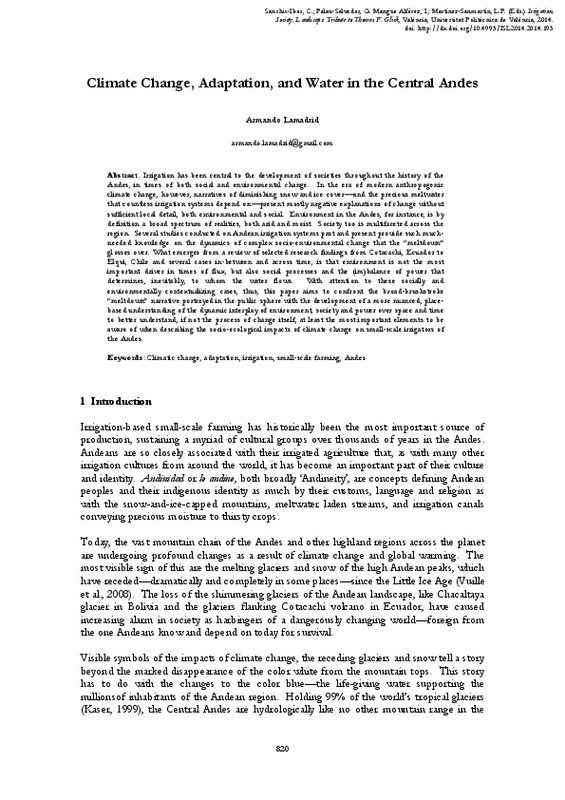JavaScript is disabled for your browser. Some features of this site may not work without it.
Buscar en RiuNet
Listar
Mi cuenta
Estadísticas
Ayuda RiuNet
Admin. UPV
Climate Change, Adaptation, and Water in the Central Andes
Mostrar el registro sencillo del ítem
Ficheros en el ítem
| dc.contributor.author | Lamadrid, Armando
|
es_ES |
| dc.coverage.spatial | east=-66.7752481; north=-21.1607667; name= Andes, Bolívia | |
| dc.date.accessioned | 2017-09-28T08:58:57Z | |
| dc.date.available | 2017-09-28T08:58:57Z | |
| dc.date.issued | 2015-03-03 | |
| dc.identifier.isbn | 9788490482742 | |
| dc.identifier.uri | http://hdl.handle.net/10251/88135 | |
| dc.description.abstract | [EN] Irrigation has been central to the development of societies throughout the history of the Andes, in times of both social and environmental change. In the era of modern anthropogenic climate change, however, narratives of diminishing snow and ice cover—and the precious meltwater that countless irrigation systems depend on—present mostly negative explanations of change without sufficient local detail, both environmental and social. Environment in the Andes, for instance, is by definition a broad spectrum of realities, both arid and moist. Society too is multifaceted across the region. Several studies conducted on Andean irrigation systems past and present provide such muchneeded knowledge on the dynamics of complex socio-environmental change that the “meltdown” glosses over. What emerges from a review of selected research findings from Cotacachi, Ecuador to Elqui, Chile and several cases in-between and across time, is that environment is not the most important driver in times of flux, but also social processes and the (im)balance of power that determines, inevitably, to whom the water flows. With attention to these socially and environmentally contextualizing cases, thus, this paper aims to confront the broad-brushstroke “meltdown” narrative portrayed in the public sphere with the development of a more nuanced, placebased understanding of the dynamic interplay of environment, society and power over space and time to better understand, if not the process of change itself, at least the most important elements to be aware of when describing the socio-ecological impacts of climate change on small-scale irrigators of the Andes | es_ES |
| dc.format.extent | 13 | es_ES |
| dc.language | Inglés | es_ES |
| dc.publisher | Editorial Universitat Politècnica de València | es_ES |
| dc.relation.ispartof | Irrigation, Society and Landscape. Tribute to Tom F. Glick | es_ES |
| dc.rights | Reconocimiento - No comercial - Sin obra derivada (by-nc-nd) | es_ES |
| dc.subject | Irrigation | es_ES |
| dc.subject | Society | es_ES |
| dc.subject | Landscape | es_ES |
| dc.subject | Regadío | es_ES |
| dc.subject | Sociedad | es_ES |
| dc.subject | Territorio | es_ES |
| dc.subject | Paisaje | es_ES |
| dc.subject | Patrimonio hidráulico | es_ES |
| dc.subject | Water heritage | es_ES |
| dc.title | Climate Change, Adaptation, and Water in the Central Andes | es_ES |
| dc.type | Capítulo de libro | es_ES |
| dc.type | Comunicación en congreso | es_ES |
| dc.identifier.doi | 10.4995/ISL2014.2014.195 | |
| dc.rights.accessRights | Abierto | es_ES |
| dc.description.bibliographicCitation | Lamadrid, A. (2015). Climate Change, Adaptation, and Water in the Central Andes. En Irrigation, Society and Landscape. Tribute to Tom F. Glick. Editorial Universitat Politècnica de València. 820-832. https://doi.org/10.4995/ISL2014.2014.195 | es_ES |
| dc.description.accrualMethod | OCS | es_ES |
| dc.relation.conferencename | Irrigation, Society and Landscape. Tribute to Tom F. Glick | es_ES |
| dc.relation.conferencedate | September 25-27,2014 | es_ES |
| dc.relation.conferenceplace | Valencia, Spain | es_ES |
| dc.relation.publisherversion | http://ocs.editorial.upv.es/index.php/ISL/ISL2014/paper/view/195 | es_ES |
| dc.description.upvformatpinicio | 820 | es_ES |
| dc.description.upvformatpfin | 832 | es_ES |
| dc.type.version | info:eu-repo/semantics/publishedVersion | es_ES |
| dc.relation.pasarela | OCS\195 | es_ES |








